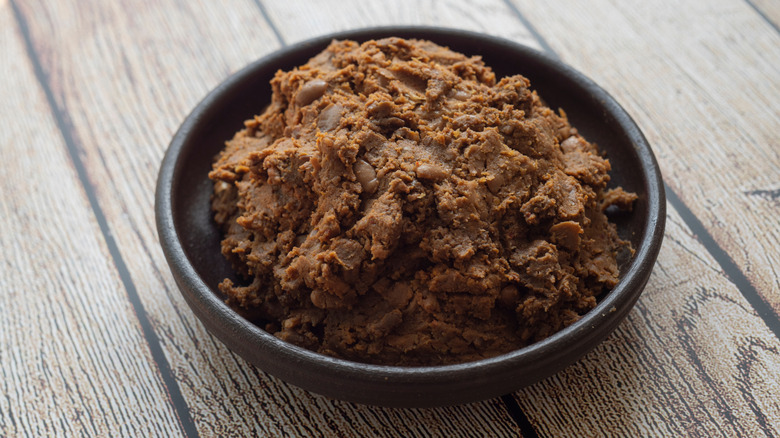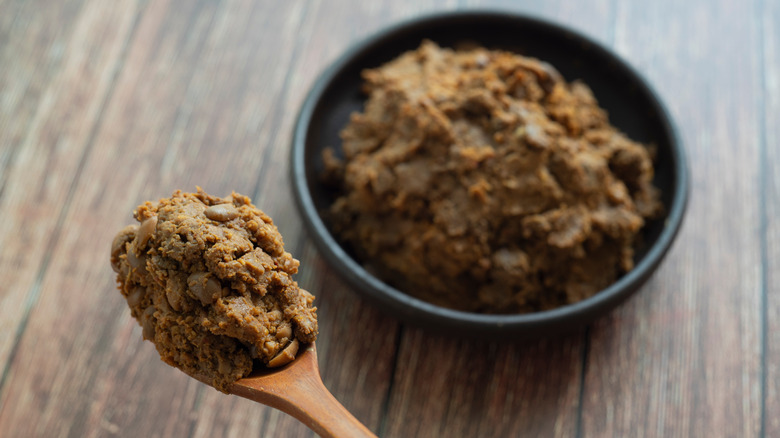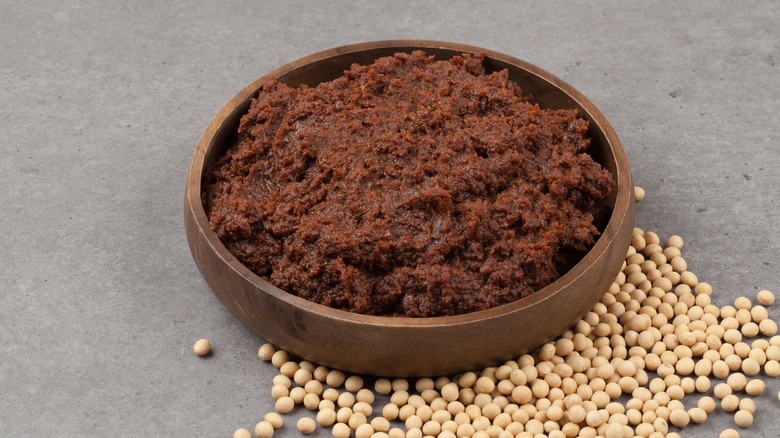The Miso Alternative You Need For Bolder Flavors
Miso is a staple in Japanese cuisine, but it has long since transcended borders in popularity. Miso soups would cease to exist without their quintessential ingredient, and its presence would be sorely missed in delicately seasoned ramen broths no doubt — but the fermented soybean paste has become a vital paste for more than just Japanese cuisine. Miso's umami flavor can add life to plain spaghetti sauces and boxed chicken broth; its salty, savory tang can breathe life into everyday scrambled eggs; miso can be the secret that has everyone raving about your mashed potatoes over the holidays; and if you were to ask TikTok, it would tell you that miso has the power to make the already perfect dish that is garlic bread even better — imagine that!
But if miso already has a place in your pantry, it's time to meet another flavor bomb from its neighboring country of Korea: doenjang. Much like miso, doenjang is a fermented soybean paste that shares miso's thick consistency and its complex flavor profile, which is why it can work as miso's substitute in a pinch. What you should also know, however, is that you'd only need half the amount of doenjang to replicate miso's flavors; doenjang is sharper, more intense, and has more of an in-your-face punchiness to it than the subtle flavors of miso. This is also why doenjang deserves its own spot in your pantry — it's more than just a miso alternative.
What is doenjang?
Doenjang has been around for more than 2,000 years, since a time when different forms of fermented soybeans (soy sauce for example) first began to form the cornerstones of Korean cuisine. Soaked soybeans were boiled in salt water and pounded into firm blocks, which were left to dry and ferment naturally over time. The fermented soybeans were then left in earthenware pots filled with salty brine to undergo another stage of fermentation, and then the blocks would later be mashed into paste-like doenjang — whereas the liquid would be turned into soy sauce.
Doenjang is still made in the same way though there are more modern methods to make the process speedier with the help of starch-based starters. The period of fermentation, however, affects doenjang's color — longer fermentation and more exposure to oxygen will give doenjang a darker shade. Regardless of how long it is fermented, however, doenjang has a salty, earthy, and savory richness that makes it the building block for many Korean stews or jjigae. Doenjang is thought to be ghochujang's not-so-spicy cousin (albeit a lesser-known one outside Korea) and together they create ssamjang — a thick paste that is smeared on leaves and wrapped around barbecued meats.
Doenjang versus miso
Considering its flavor, consistency, and ingredients, doenjang may seem very similar to miso and an efficient alternative to it — but there are nuanced differences between the two. Doenjang and miso both begin with soybeans though the latter uses koji, grains, and salt. Doenjang relies only on salt for fermentation (barring some factory-produced pastes that may use additives). Doenjang also has a grainier consistency akin to chunky peanut butter — unlike miso, which is smooth and buttery instead.
Furthermore, some varieties of miso are ready for consumption within a week of fermentation while doenjang requires a minimum of six weeks, if not longer. The longer ferment boosts doenjang's umaminess concurrently increasing its sweet and bitter flavors. Doenjang has a pungent complexity that is similar to that of Parmesan cheese. Miso has a degree of umami but is milder and more subdued in comparison. This is why doenjang is an excellent alternative to miso when you want a bolder flavor, and is an equally worthy fermented soybean paste to be used in its own right.
Doenjang can be used to whip up say doenjang jjigae — a stew of water, tofu, and vegetables — in dressings for salads, to tie colorful bibimbap together, to whisk into sauces for stir-fries, or in marinades for meats. Doenjang is also a fantastic addition to chip-and-dip platters either on its own or seasoned with herbs and sesame seeds. No matter how you use it, it will quickly become a staple!



